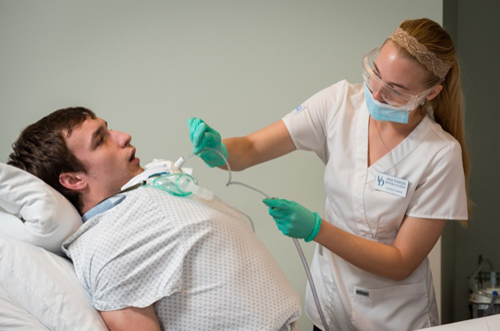Mechanical engineering students invent device to improve nursing education
Every young inventor dreams of creating the next smart phone, social networking site, or artificial organ.
For five mechanical engineering students at the University of Delaware, that dream came one step closer to reality when a representative of Laerdal Medical visited campus to learn more about SimuTrach, a device they invented to provide realistic training for the care of tracheostomy patients.
An overlay worn by actors playing the role of patients in simulation training, SimuTrach is a new tool in UD’s Healthcare Theatre Program, which helps health care professionals develop communication and treatment skills through interactive scenarios presented by theatre students.
On May 21 and 22, David LaCombe, regional portfolio director for emergency care at Laerdal, met with representatives of UD’s Office of Economic Innovation and Partnerships (OEIP), toured engineering and health sciences facilities, and talked with the inventors.
OEIP Director David Weir views Laerdal as an ideal partner for the University. The company, which is perhaps best known for its resuscitation-training manikin Resusci Anne, provides educational and therapy products for lifesaving and emergency medical care.

Nursing student Julia Tuhacek demonstrates SimuTrach on HealthCare Theatre actor Neil Redfield during a visit from David LaCombe of Laerdal Medical. Photos by Kathy F. Atkinson and Doug Baker
The path to entrepreneurship
Mechanical engineering students Brad Biggs, Devon Bond, Nick Campagnola, Ed Doll, and Nate Hott developed the first SimuTrach prototype in their senior design class at the request of Amy Cowperthwait, nursing instructor and co-founder of Healthcare Theatre.
The team further developed the device through First Step, a program in the College of Health Sciences designed to promote innovation and entrepreneurship among undergraduates. The project received the first-place award in First Step, where additional funding and mentoring will facilitate taking the project to the next level.
SimuTrach has also been adopted into OEIP’s Spin In program, which matches entrepreneurs developing innovative early-stage technology with a team of UD business students to further develop both the technology and the marketing strategy.

Co-inventor Nick Campagnola explains the inner workings of SimuTrach to David LaCombe of Laerdal Medical. Photos by Kathy F. Atkinson and Doug Baker
Industry interest
LaCombe’s visit included a Healthcare Theatre performance at the Health Sciences Complex on UD’s new Science, Technology and Advanced Research (STAR) Campus to demonstrate the use of SimuTrach.
“We’re basically a health care education company looking at different ways to achieve our mission of helping to save lives,” LaCombe said. “We know that providing students with feedback results in great strides in learning. This performance fits in that wheelhouse and makes a lot of sense. It’s very relevant, and it definitely fits with our interests.”
“I’m also impressed that the device is at a stage where it doesn’t have to be conceptualized,” he added.
For OEIP’s Weir, the talks with Laerdal are part of an overall effort to foster entrepreneurship and build relationships with private companies.
“It’s not necessarily about licensing the technology but rather about building our research enterprise through partnerships,” he said.
From First Step to next steps
SimuTrach is currently on its third prototype, with each version offering improved features and functionality, from the lung sound to the skin feel.
The team is now working on branding, pricing, identifying partners, and creating a marketing plan. They have identified up to 5,000 potential customers for the device in the U.S. alone, including nursing institutions, respiratory therapy clinics, and medical practices.
According to co-inventor Campagnola, SimuTrach offers a number of benefits over the use of manikins for tracheostomy training, including reduced cost as well as increased portability and ease of use.
“It also offers an improved educational experience for the student and increased communication with the patient, and it enables the instructor to get a complete picture of the student’s performance,” he said.
Jenni Buckley, assistant professor who teaches the mechanical engineering senior design course at UD, is as proud of SimuTrach as she would be if the inventors were her own children.
“This project is a great example of what UD students can do,” she said. “They brought the idea all the way from a clinician’s concept sketch to really mature, functional prototypes. They designed and ran clinical trials, which showed the effectiveness of the systems in training nurses, and they submitted the results for publication in a medical journal. Then they finished it all off by pitching their design to a major medical simulation company.”
Perhaps SimuTrach will be the next Resusci Anne.
About OEIP
Since its formation in 2008, under the direction of former DuPont vice president for research and development David Weir, OEIP has worked with the state, Delaware Technology Park, and numerous researchers and companies in creating a culture where innovation and entrepreneurship can thrive in Delaware.
– Article by Diane Kukich
*Source: University of Delaware
